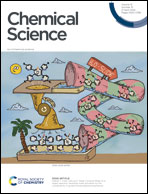Efficient near-infrared emission benefits from slowing down the internal conversion process†
Abstract
Organic deep-red (DR) and near-infrared (NIR) emitters with high photoluminescence quantum yield (PLQY) are rare due to the strong non-radiative (knr) decay. Here, we report two DR/NIR emitters with high PLQY, TPANZPyPI and TPANZ3PI. Interestingly, the TPANZPyPI film exhibits 46.5% PLQY at 699 nm. Theoretical calculations indicate that TPANZPyPI can achieve this high PLQY in the near-infrared emission region due to its small S1 to S0 internal conversion (IC) rate. Meanwhile, research has found that, compared to TPANZ3PI, TPANZPyPI with a more rigid structure can effectively suppress the T2 to T1 IC process, which is conducive to higher exciton utilization efficiency (EUE). TPANZPyPI's non-doped OLED shows NIR emission with 4.6% @ 684 nm maximum external quantum efficiency (EQEmax). Its doped OLEDs radiate DR with an EQEmax of 6.9% @ 666 nm. These EQEs are among the highest values for hybridized local charge transfer state materials emitting more than 640 nm. This work demonstrates for the first time, based on a combination of theory and experiment, that increasing the molecular rigidity can inhibit the excited state IC process in addition to the S1 to S0 IC, realizing efficient electroluminescence.



 Please wait while we load your content...
Please wait while we load your content...